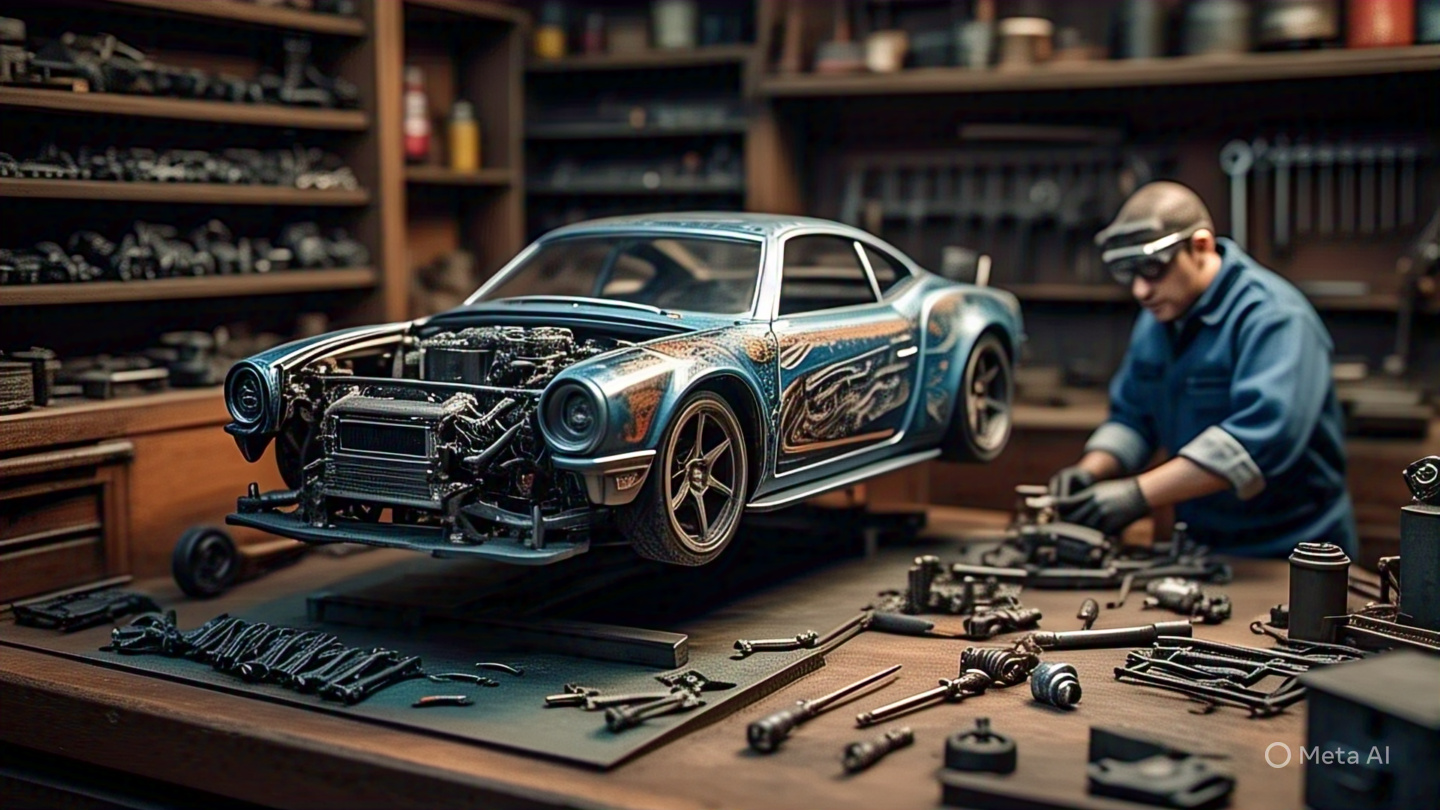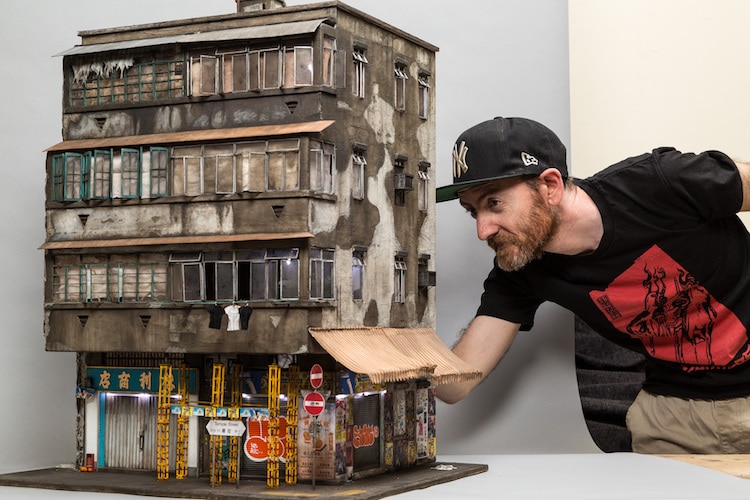Introduction to Dioramas
Dioramas are captivating three-dimensional representations that depict a particular scene or environment, allowing observers to engage with a slice of reality or fantasy in a controlled miniature format. Historically, diorama-making has roots that stretch back to the early 19th century, with the term itself originating from the Greek words for “through” and “that which is seen.” These art forms gained prominence as educational tools in museums, helping to illustrate natural history and cultural phenomena effectively, while also serving as an artistic outlet for creative individuals.
At their core, dioramas can encapsulate various themes, ranging from historical battles and nature scenes to imaginary landscapes, effectively transporting viewers into a different realm. This artistic endeavor not only stimulates creativity but also enhances observational skills, as the creator must pay meticulous attention to detail in constructing their miniature worlds. As a result, diorama-making has developed into a beloved hobby for countless individuals, offering an engaging way to express artistic vision and storytelling prowess.
The appeal of creating dioramas is further magnified in the context of budget-friendly projects that utilize readily available scrap materials. This approach not only encourages resourcefulness but also fosters a sense of environmental stewardship, as it promotes recycling and repurposing discarded items. By participating in a budget build challenge, hobbyists can explore their creativity without the constraints of significant financial investment, paving the way for an expansive world where imagination takes precedence over expense. Ultimately, dioramas serve as not just artistic expressions but also as educational instruments, inspiring both their creators and audiences alike.
The Joy of Scrap Materials
Utilizing scrap materials for diorama construction presents numerous advantages, transforming what might otherwise be discarded into components of creative expression. Engaging in this form of crafting fosters resourcefulness and ingenuity, allowing hobbyists to create unique scenes without significant financial investment. One of the principal benefits is the opportunity to save costs by repurposing items already available at home or within the community.
Common sources of scrap materials can be found in various corners of our living spaces. Cardboard, for instance, can be sourced from packaging boxes, food cartons, or even old books. This readily accessible material can serve as both the base and structural elements of a diorama, providing versatility in design. Furthermore, broken toys or figurines can be disassembled, offering miniature figures and ornaments that can bring scenes to life. Such items often carry sentimental value, enriching the overall narrative of the diorama.
Natural elements are another excellent source of materials. Items like twigs, stones, and leaves can enhance authenticity and detail, reflecting real-world environments. Collecting these from parks or gardens not only adds to the diorama’s aesthetic appeal but also promotes a connection to nature and community settings. This practice encourages sustainable crafting, aligning with environmentally friendly values by reducing waste and repurposing forgotten treasures.
In addition to cost-effectiveness and environmental considerations, the act of constructing a diorama from scrap materials can be immensely satisfying. The creative process often leads to innovative results that might not be achievable using standard items from craft stores. Ultimately, the joy found in using scrap materials transcends mere construction; it provides an outlet for personal expression and an opportunity to cultivate new skills in budgeting and environmental consciousness.
Planning Your Diorama: Design and Theme Choices
When embarking on the journey to create a captivating diorama, the initial step involves thorough planning. Choosing an appropriate theme or narrative is paramount, as it lays the foundation for the entire project. Potential themes can be drawn from a myriad of sources, including literature, cinematic works, or personal experiences. For instance, one might transform scenes from a favorite book into a three-dimensional representation, allowing for a visual storytelling experience that resonates on a personal level.
Inspiration can also be garnered from nature, history, or abstract concepts, offering limitless possibilities for development. Once a theme has been identified, it is advisable to create a storyboard to organize thoughts and visualize how the final diorama will appear. Storyboarding effectively maps out the key elements of the piece, ensuring that your ideas are cohesive and focused. Drawing sketches or creating digital designs can help crystallize details such as layout, scale, and colors, making it easier to transition from concept to physical creation.
Furthermore, during this planning stage, it is essential to consider the materials available for your budget build challenge. Scrap materials can be creatively integrated to enhance the thematic elements, from reclaimed cardboard to plastic containers. Assessing these resources early on will allow for innovative solutions and help avoid potential obstacles during the construction phase. By thoughtfully planning the design and theme, builders can create a diorama that captures both the essence of their vision and the intricate details that breathe life into the piece.
Essential Tools and Materials for Your Build
When embarking on the exciting journey of creating a diorama from scrap materials, having the right tools and materials at your disposal is crucial. Fortunately, many essential items needed for a successful build can often be found around your home, significantly lowering costs while still allowing for creativity and innovation.
First and foremost, a good pair of scissors is vital for cutting various materials such as cardboard, paper, and thin plastic sheets. If investing in a new pair is not feasible, often, any quality household scissors can do the trick. Additionally, consider using a utility knife for precise cuts, especially on tougher materials. A craft knife can also be beneficial for intricate work.
Another indispensable tool is glue. While specialty adhesives can be purchased, basic white school glue or a strong rubber adhesive found in most households can serve just as effectively for bonding paper and lightweight materials. For heavier items or quick fixes, a glue gun can be invaluable, allowing for a fast-setting, durable bond.
Paint is another essential element when crafting your diorama. Acrylic paints are widely regarded for their versatility and ease of use. However, you can substitute these with leftover wall paint or even food coloring mixed with water for a budget-friendly alternative. Brushes and applicators can be as simple as old toothbrushes or sponges from your kitchen to create interesting textures and effects.
Finally, consider textures such as sand, soil, or small stones from your yard or local park, which can add realistic details to your diorama landscape. Using household items like cereal boxes, plastic containers, and fabric scraps helps enhance the visual appeal without the need for expensive materials.
Step-by-Step Guide to Building Your Diorama
Constructing a captivating diorama can be an enriching and creative experience that allows you to express your artistic vision while utilizing available resources. To begin the diorama building process, first gather your materials. For the base, consider using a sturdy piece of cardboard or foam board, which will provide a reliable foundation. Cut your base to the desired size, keeping in mind the scale of your diorama. Once the base is prepared, create a skirting using additional materials such as paper, fabric, or natural elements, which can serve as a backdrop for your scene.
Next, it’s crucial to build layers that will contribute to the overall depth of your diorama. Start by applying a base layer of soil or sand to create ground texture. This initial layer is fundamental for grounding your composition and can be adhered using a mix of glue and water to ensure it stays in place. As you add layers, consider using various materials such as pebbles, twigs, and moss; these will enhance the organic reality of your diorama while allowing you the freedom to improvise. Experimenting with heights and forms will create visual interest and enhance the storytelling aspect of your piece.
After setting the foundational elements, you can focus on texturing and detailing for a more vibrant presentation. Paint and glue can be strategically applied to add color and life to your diorama. Incorporate miniature figures, animals, or unique structures that resonate with your theme to further enrich the scene. Creativity is key during this phase; embrace the opportunity to utilize unconventional materials, such as bits of scrap metal or old toys, to add distinctive characteristics to your diorama. Through innovation in your approach to texturing and detailing, you can transform your diorama into a captivating narrative piece that showcases both your story and your creative flair.
Painting and Finishing Touches
The painting process is crucial in bringing a diorama to life, as it adds depth, character, and realism to the scene. Choosing the right colors is essential; consider the mood you want to convey. For instance, earthy tones often work well for landscapes, while vibrant shades can enhance architectural features or characterize particular elements within your scene. When selecting colors, keep in mind that they should complement each other to maintain cohesion in the overall design.
Once you have selected your color palette, it’s beneficial to experiment with various painting techniques to add texture and depth. Dry brushing is a popular method where a brush with minimal paint is used to lightly accentuate raised surfaces. This technique is particularly effective for highlighting details on rocks, buildings, or figurines, creating an illusion of weathering or sun-bleached effects. Additionally, using washes—a thinned-down paint applied over a surface—can effectively enhance shadows and bring out fine details, especially in crevices and gaps.
Weathering effects are another important aspect in achieving a realistic diorama. Techniques such as sponging can simulate rust or peeling paint, lending authenticity to your creation. Using leftover paints from previous projects can significantly cut costs while allowing for creative flexibility. Mixing these paints can yield unique tones that serve to enhance the various components of your diorama. For a coherent look, try to incorporate similar colors across different elements.
Finally, think about adding small finishing touches. Details such as tiny flecks of grass, shimmering water effects, or even dust can provide your diorama with that extra bit of realism. Incorporating these finishing touches will not only enhance the visual appeal of your creation but also reflect the care and craftsmanship poured into the project. Crafting a compelling diorama from scrap necessitates patience and creativity, resulting in a unique display that captures the imagination.
Showcasing Your Diorama: Display Ideas
Once you have meticulously crafted your diorama, showcasing it effectively is paramount to ensure that your hard work is appreciated. The presentation can significantly enhance the impact of the model, transforming it from just a creation into a captivating scene that draws attention. Below are several strategies to display your diorama that highlight its intricate details.
Lighting plays a crucial role in how viewers perceive your diorama. Natural light is often ideal, so consider placing the diorama near a window where it can benefit from soft, diffused sunlight. However, if indoor lighting is preferred, using adjustable LED lights can effectively illuminate your project without casting harsh shadows. Consider using warm white bulbs to create a cozy atmosphere or colored lights to evoke a specific mood or theme. These lighting options will provide a three-dimensional effect, enhancing the overall realism of the scene.
The background and setting for your diorama are also essential aspects of the display. A neutral or complementary background can allow the diorama to stand out without distraction. You may opt for plain fabrics, solid-color backdrops, or even thematic panels that resonate with the diorama’s theme. Additionally, incorporating elements such as small plants, figures, or thematic accessories around the display area can enrich the narrative, inviting viewers to explore its details further.
Lastly, consider the placement of the diorama within your home or community. A prominent location, such as a living room shelf, a dedicated display cabinet, or a community event, can draw curious eyes and initiate conversation about your work. Elevate its visibility by ensuring it is at eye level and unobstructed. These thoughtful display strategies will not only showcase your diorama effectively but will also celebrate the creativity and effort invested in its creation.
Sharing Your Creativity: Community and Feedback
Creating a captivating diorama from scrap materials not only showcases your ingenuity but also connects you with a vibrant community of fellow creators. Sharing your completed pieces can lead to meaningful interactions and feedback that help you refine your craft. There are several avenues available for enthusiasts looking to display their work and gain insights from others.
Social media platforms like Instagram and Facebook present excellent opportunities for sharing your dioramas. Instagram, in particular, allows for visually oriented posting, making it easy to capture the intricate details of your work. Utilizing relevant hashtags such as #DioramaChallenge, #ScrapDiorama, and #BudgetBuild can enhance your visibility, attracting both hobbyists and professionals who can offer constructive feedback. Likewise, Facebook offers specialized groups dedicated to crafting and diorama building, allowing for direct interactions with like-minded individuals.
Online forums like Reddit also feature various subreddits focused on crafting. Subreddits such as r/diaramas and r/DIY encourage users to share their creations, ask for advice, and engage in discussions about tools and techniques. By participating in these communities, you open yourself up to a wealth of information and inspiration from diverse voices catering to similar interests.
Local crafting groups or workshops can be a fantastic way to connect on a personal level. Many communities host regular meetups, allowing you to present your work in a supportive environment. Other crafters can offer insights and alternative ideas that can enhance your future projects. Moreover, these gatherings often inspire others to embark on their own budget build challenges, promoting a cycle of creativity and engagement.
Ultimately, sharing your diorama not only fosters personal growth but also adds to the collective knowledge of crafting communities. Embracing feedback and lending support to fellow enthusiasts enriches the experience of creating art from scrap materials.
Conclusion
In the realm of diorama creation, the journey extends beyond mere construction; it is a profound exploration of creativity and resourcefulness. Engaging in a budget build challenge compels enthusiasts to tap into their imaginative faculties, transforming what might be perceived as scrap into captivating miniatures. This process not only cultivates individual artistic expression but also underscores the importance of viewing materials in versatile ways.
When embarking on this crafting adventure, one learns to appreciate the value of each item. Even the most seemingly insignificant scraps can yield stunning results when combined thoughtfully. This ideology encourages practitioners to break free from traditional constraints, fostering a mindset that celebrates innovation and ingenious problem-solving. As you navigate through your own build, reflect on the myriad possibilities that lie within your creative reach.
Moreover, adaptability plays a crucial role throughout this process. As challenges arise, be it in sourcing materials or devising construction techniques, the ability to pivot and rethink strategies can lead to unexpected outcomes—sometimes even more extraordinary than what was initially envisioned. This adaptability not only enhances the diorama-building experience but also instills a creative resilience that is invaluable in all aspects of life.
As you complete your diorama, consider the unique story each piece tells and the journey you undertook to create it. Sharing your experience and insights with fellow crafters can inspire a community of creativity, sparking purpose and collaboration. So, embrace this opportunity to think outside the box; let the act of crafting from scrap materials empower your artistic journey. With each challenge, reinforce the value of imagination and resourcefulness, as these traits are the true essence of art and craftsmanship.





